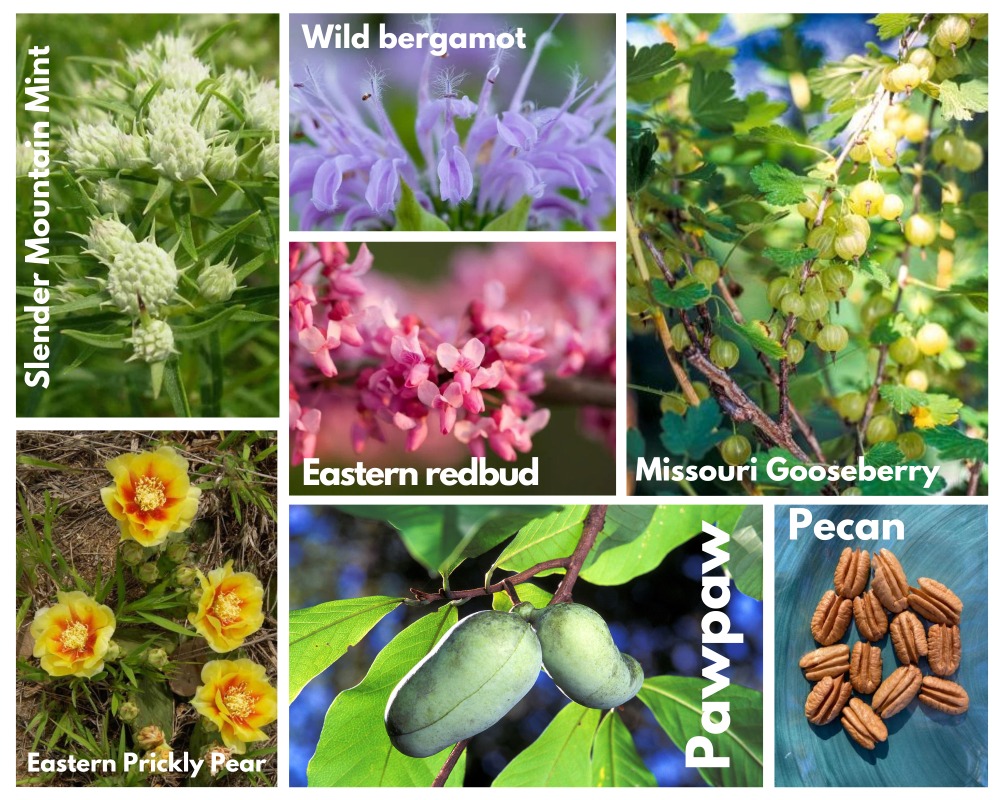
A highlight of my daily life is watching wild creatures using my native wildflower gardens. An assortment of birds glean seeds from the flower heads during the fall and winter and forage for insects during the summer. We host American toads, at least four species of bumble bees, honey bees, and many other insects. Both hummingbirds and the hummingbird-like sphynx moth visit in search of nectar.
I’ve mostly considered my native garden as decorative with some ecological benefits — until now.
In March, I attended one of the Missouri Department of Conservation’s online programs focused on gardening with native plants that are also edible. It was great timing for me because I’m expanding my vegetable garden this year. Here are some reasons to include natives in your ‘vegetable’ gardens or add them to your flower gardens:
- Planting your own native edibles provides more convenient harvests for you and leaves the wild plants for the other animals that depend on them;
- Native plants are good for our local ecosystem, obviously;
- They are (usually) easy to grow and more likely to be resistant to predation from wildlife;
- You can have something different than everyone else!
Here are a few highlights from the program and a link to the entire slide presentation, which was hosted by MDC naturalists Jordi Raos and Morgan Wyatt.
Some native berries and fruits you can include in your garden are serviceberry, golden currant, gooseberry, or passion flower. You can also considering growing a fruiting native tree such as pecan, hazelnut, persimmon (only if you like them), paw paw or wild plum. Many of the natives you already have in your garden (or nearby) may be edible:
- Common violet, Viola sororia, is commonly found in lawns and elsewhere. The flowers and leaves are edible. You can use the leaves as a potherb.
- Wild bergamot, Monarda fistulosa: this wild bergamot is going to be a little milder flavor than it’s relative beebalm, Monarda braburniana. Use as a herb or for tea, leaves and flowers.
- Cutleaf coneflower, Rudibeckia laciniata, is a tall yellow composite flower. Use the leaves as a potherb or green.
- Wood nettle, Laportea canadensis, is one you might consider it a weed, but with careful handling, the leaves are a very nutritious potherb.
- Dittany/Wild Oregano, Cunila origanoides. You can use the leaves as you would oregano.
- Slender mountain mint, Pycanthemum tenuifolium: use the leaves dried or fresh as you would with regular mint.
As for me, I’m particularly excited to start a patch of two useful perennials. Jerusalem artichoke (Sunchoke), Helianthus tuberosis is known for its edible roots. These hardy plants take a couple of years to grow a tuber big enough to harvest. Once you get them established they will replenish themselves if you limit your harvest. In the meantime, you’ll have a prolific stand of tall, yellow sunflowers to admire. In the late summer, the bees and other pollinators will flock to them, and birds will relish their seeds as well.
I’m also trying to find some Apios americana, also known as hopniss or American groundnut. It was once a staple food for many American Indian cultures. All parts of this leguminous vine are edible, including the pods of beans it produces, but the tubers are the real treasure. They are purported to be similar to a potato but sweeter and a little nutty. Like potatoes they are starchy, but they also have twice the protein of a potato! There’s a wonderful article about them in Orion magazine.
If you’re interested in adding more edible native plants to your gardens, here are a few resources:
- Some relevant resources from your Library
- Native Plant Vendors & Services
- Online Resources and Databases to Native Plants of Missouri
- MDC Online Field Guide
- Native Plant Database
- Missouri Botanical Gardens Plant Finder (Makes sure to check “Missouri Natives” and use the Advanced Search.)



